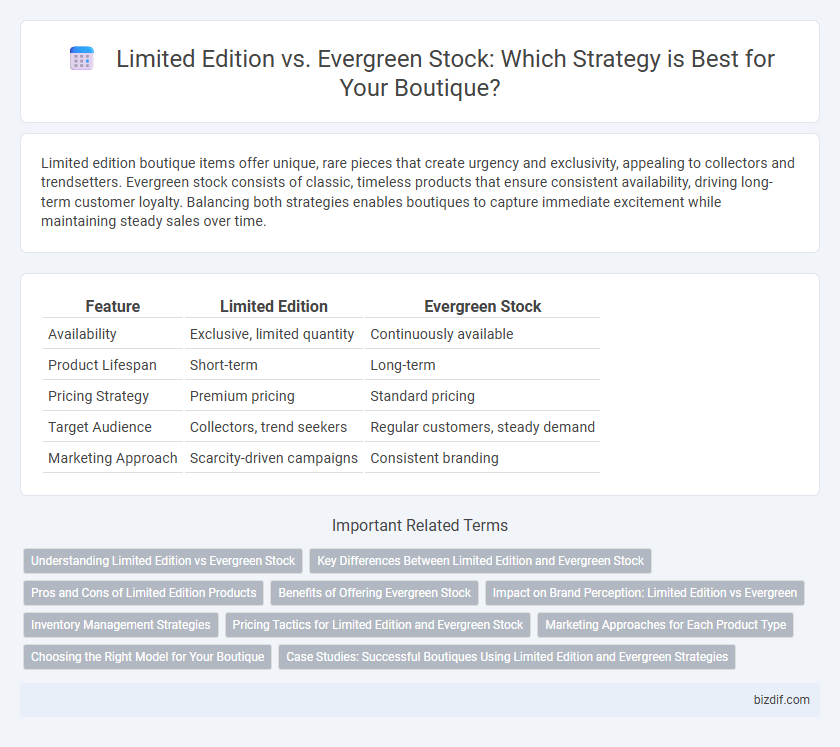Limited edition boutique items offer unique, rare pieces that create urgency and exclusivity, appealing to collectors and trendsetters. Evergreen stock consists of classic, timeless products that ensure consistent availability, driving long-term customer loyalty. Balancing both strategies enables boutiques to capture immediate excitement while maintaining steady sales over time.
Table of Comparison
| Feature | Limited Edition | Evergreen Stock |
|---|---|---|
| Availability | Exclusive, limited quantity | Continuously available |
| Product Lifespan | Short-term | Long-term |
| Pricing Strategy | Premium pricing | Standard pricing |
| Target Audience | Collectors, trend seekers | Regular customers, steady demand |
| Marketing Approach | Scarcity-driven campaigns | Consistent branding |
Understanding Limited Edition vs Evergreen Stock
Limited edition stock in boutiques offers exclusive, time-sensitive products that drive urgency and appeal to collectors or trend-focused customers, often leading to higher perceived value and quicker turnover. Evergreen stock consists of essential, consistently available items that ensure steady revenue and customer satisfaction by meeting ongoing demand without frequent restocking urgency. Understanding the balance between limited edition and evergreen stock helps boutiques optimize inventory, maximize profitability, and cater to diverse consumer preferences effectively.
Key Differences Between Limited Edition and Evergreen Stock
Limited edition stock in a boutique is characterized by exclusive, scarce items produced in small quantities, driving urgency and uniqueness for customers. Evergreen stock maintains consistent availability, offering staple products that sustain steady sales and brand identity over time. The key difference lies in scarcity and sales strategy--limited editions create short-term demand spikes, while evergreen stock ensures long-term revenue stability.
Pros and Cons of Limited Edition Products
Limited edition products in boutiques create exclusivity and urgency, attracting collectors and enthusiasts willing to pay premium prices for rare items. The limited availability can boost brand prestige and generate buzz, but also risks disappointing customers when stock runs out quickly or fails to meet demand. These products require careful inventory management and marketing strategies to balance scarcity with profitability.
Benefits of Offering Evergreen Stock
Offering evergreen stock in a boutique ensures consistent product availability, enhancing customer loyalty and trust. This strategy reduces inventory risks by maintaining popular, timeless items that generate steady revenue year-round. Evergreen stock also simplifies inventory management and supports a stable brand identity by focusing on classic, best-selling pieces.
Impact on Brand Perception: Limited Edition vs Evergreen
Limited edition products create a sense of exclusivity and urgency, enhancing brand prestige and attracting collectors who value rarity. Evergreen stock, available consistently, builds long-term trust and reliability, emphasizing the brand's commitment to quality and sustained customer satisfaction. Balancing limited editions with evergreen offerings can strengthen overall brand perception by appealing to both exclusivity seekers and loyal customers.
Inventory Management Strategies
Limited edition inventory drives exclusivity and urgency, encouraging rapid turnover and premium pricing in boutique settings. Evergreen stock provides consistent availability, ensuring steady sales and long-term customer satisfaction through reliable replenishment. Effective boutique inventory management balances limited edition appeal with evergreen reliability to optimize cash flow and brand prestige.
Pricing Tactics for Limited Edition and Evergreen Stock
Limited edition products often use dynamic pricing tactics that emphasize scarcity, allowing boutiques to implement premium pricing strategies based on exclusivity and limited availability. Evergreen stock tends to follow competitive pricing models designed for consistent sales, focusing on affordability and steady demand rather than scarcity. Strategic pricing differentiation maximizes revenue by leveraging the unique value propositions of both limited edition and evergreen inventory.
Marketing Approaches for Each Product Type
Limited edition products leverage scarcity marketing, driving urgency and exclusivity to boost immediate sales and brand desirability. Evergreen stock relies on consistent demand and steady availability, supported by ongoing content marketing and customer loyalty programs to maintain long-term revenue. Combining targeted email campaigns for limited editions with SEO-optimized product pages for evergreen items maximizes overall boutique profitability.
Choosing the Right Model for Your Boutique
Limited edition products create urgency and exclusivity, driving higher perceived value and fast sales in boutique settings. Evergreen stock ensures consistent availability and steady revenue, supporting customer loyalty with staple items that define your brand. Balancing limited editions with evergreen inventory helps boutiques optimize variety, manage risk, and meet diverse customer preferences effectively.
Case Studies: Successful Boutiques Using Limited Edition and Evergreen Strategies
Successful boutiques leveraging limited edition strategies often capitalize on scarcity to create urgency, such as Supreme's exclusive streetwear drops generating rapid sellouts and heightened brand prestige. Evergreen stock strategies, exemplified by luxury brand Hermes, ensure consistent sales through timeless pieces like the Birkin bag, maintaining high demand and customer loyalty over time. Case studies highlight that combining limited edition releases with a strong evergreen core allows boutiques to balance immediate revenue spikes and sustained market presence effectively.
Limited Edition vs Evergreen Stock Infographic

 bizdif.com
bizdif.com